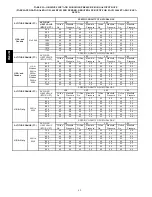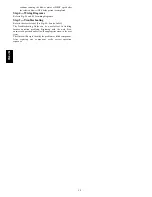
49
FIRE OR EXPLOSION HAZARD
Failure to follow this warning could result in personal
injury, death and/or property damage.
Never use a match or other open flame to check for gas
leaks. Use a soap--and--water solution.
!
WARNING
19. Check for gas leaks.
20. Replace outer access door.
Step 3
—
Sequence of Operation
NOTE
: Furnace control must be grounded for proper operation
or control will lock out. Control is grounded through
green/yellow wire routed to gas valve and manifold bracket
screw.
Using the schematic diagram in Fig. 46, follow the sequence of
operation through the different modes. Read and follow the
wiring diagram very carefully.
NOTE
: If a power interruption occurs during a call for heat (W),
the control will start a 90--sec blower--only ON period two
seconds after power is restored, if the thermostat is still calling for
gas heating. The red LED light will flash code 12 during the
90--sec period, after which the LED will be ON continuous, as
long as no faults are detected. After the 90--sec period, the furnace
will respond to the thermostat normally.
The blower door must be installed for power to be conducted
through the blower door interlock switch ILK to the furnace
control CPU, transformer TRAN, inducer motor IDM, blower
motor BLWM, hot--surface igniter HSI, and gas valve GV.
1.
Heating
(See Fig. 26 for thermostat connections.) The wall thermo-
stat “calls for heat” closing the R--to--W circuit. The fur-
nace control performs a self--check, verifies the pressure
switch contacts PRS are open, and starts the inducer motor
IDM.
a.
Inducer Prepurge Period
-- As the inducer motor
IDM comes up to speed, the pressure switch contacts
PRS close, 24 VAC power is supplied for a field in-
stalled humidifier at the HUM terminal and the control
begins a 15--sec prepurge period.
b.
Igniter Warm--Up
-- At the end of the prepurge period,
the Hot--Surface igniter HSI is energized for a
17--second igniter warm--up period.
c.
Trial--for--Ignition Sequence
-- When the igniter
warm--up period is completed, the main gas valve re-
lay contacts GVR close to energize the gas valve GV,
the gas valve opens, The gas valve GV permits gas
flow to the burners where it is ignited by the HSI. Five
seconds after the GVR closes, a 2--second flame prov-
ing period begins. The HSI igniter will remain ener-
gized until the flame is sensed or until the 2--second
flame proving period begins.
d.
Flame--Proving
-- When the burner flame is proved at
the flame--proving sensor electrode FSE, the furnace
control CPU begins the blower--ON delay period and
continues to hold the gas valve GV open. If the burner
flame is not proved within two seconds, the control
CPU will close the gas valve GV, and the control CPU
will repeat the ignition sequence for up to three more
Trials--For--Ignition before going to Ignition--Lockout.
Lockout will be reset
automatically after three hours
or by momentarily interrupting 115 vac power to the
furnace, or by interrupting 24 vac power at SEC1 or
SEC2 to the furnace control CPU (not at W, G, R,
etc.).
If flame is proved when flame should not be present,
the furnace control CPU will lock out of Gas--Heating
mode and operate the inducer motor IDM until flame
is no longer proved.
e.
Blower--On Delay
-- If the burner flame is proven, the
blower motor is energized on HEAT speed 25 sec after
the gas valve GV is energized.
Simultaneously, the electronic air cleaner terminal
EAC--1 is energized and remains energized as long as
the blower motor BLWM is energized.
f.
Blower--Off Delay
-- When the thermostat is satisfied,
the R--to--W circuit is opened, de--energizing the gas
valve GV, stopping gas flow to the burners, and de--
energizing the humidifier terminal HUM. The inducer
motor IDM will remain energized for a 5--second
post--purge period. The blower motor BLWM and air
cleaner terminal EAC--1 will remain energized for 90,
120, 150, or 180 seconds (depending on the blower--
OFF delay selection). The furnace control CPU is fact-
ory--set for a 120--second blower--OFF delay.
2.
Cooling Mode
(See Fig. 26 for thermostat connections.) The thermostat
closes the R--to--G--and--Y circuits. The R--to--Y circuit
starts the outdoor unit, and the R--to--G and Y circuits start
the furnace blower motor BLWM on COOL speed. The
electronic air cleaner terminal EAC--1 is energized with
115 vac when the blower motor BLWM is operating.
When the thermostat is satisfied, the R--to--G--and--Y cir-
cuits are opened. The outdoor unit will stop, and the fur-
nace blower motor BLWM will continue operating on the
COOL speed for an additional 90 sec. Cut jumper J2 to
reduce the cooling off--delay to 5 sec. (See Fig. 25.)
3.
Continuous Blower Mode
When the R--to--G circuit is closed by the thermostat, the
blower motor BLWM will operate on continuous--blower
speed (same as HEAT speed). Terminal EAC--1 is ener-
gized as long as the blower motor BLWM is energized.
During a call for heat, the blower BLWM will stop during
igniter warm--up (17 sec), ignition, and blower--ON delay
(25 sec), allowing the furnace heat exchangers to heat up
more quickly, then restarts at the end of the blower--ON
delay period at HEAT speed.
When the thermostat “calls for cooling”, the blower motor
BLWM will operate at COOL speed. When the thermostat
is satisfied, the blower motor BLWM will operate an addi-
tional 90 sec, on COOL speed before reverting back to
continuous blower speed.
When the R--to--G circuit is opened, the blower motor
BLWM will continue operating for an additional 5 sec, if
no other function requires blower motor BLWM opera-
tion.
4.
Heat Pump
When installed with a heat pump, the furnace control auto-
matically changes the timing sequence to avoid long
blower off times during demand defrost cycles. When the
R--to--Wand-- Y or R--to--W--and--Y--and--G circuits are
energized the furnace control CPU will continue to turn on
the blower motor BLWM at HEAT speed, and begin a
heating cycle. The blower motor BLWM will remain on
until the end of the prepurge period, then shut off for 24
sec then come back on at HEAT speed. When the W input
signal disappears, the furnace control begins a normal in-
ducer post--purge period and the blower switches to
COOL speed after a 3 sec delay. If the R--to--W--and--
Y--and--G signals disappear at the same time, the blower
motor BLWM will remain on for the selected blower--
OFF delay period. If the R--to--W--and--Y signals disap-
pear, leaving the G signal, the blower motor BLWM will
PG
8J
/M




































